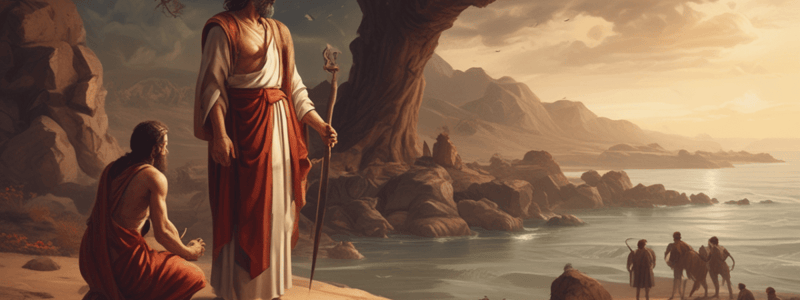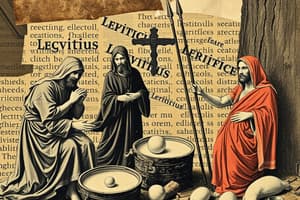Podcast
Questions and Answers
The longest description of the offerings in the priestly instructions is the sin offering.
The longest description of the offerings in the priestly instructions is the sin offering.
False (B)
Sin breaks a rupture in the relationship with Yahweh that can be repaired by the peace offering.
Sin breaks a rupture in the relationship with Yahweh that can be repaired by the peace offering.
False (B)
The burnt offering is tied to atonement, but not to consecration to Yahweh.
The burnt offering is tied to atonement, but not to consecration to Yahweh.
False (B)
The grain offering is only brought when sin is involved.
The grain offering is only brought when sin is involved.
The breach of sin is handled by the peace offering.
The breach of sin is handled by the peace offering.
The priestly offerings are the basis of atonement, but not forgiveness.
The priestly offerings are the basis of atonement, but not forgiveness.
The assurance of forgiveness comes from seeing the portion of the offering consumed on the altar.
The assurance of forgiveness comes from seeing the portion of the offering consumed on the altar.
The Old Testament offerings are a direct means of forgiveness, apart from Christ.
The Old Testament offerings are a direct means of forgiveness, apart from Christ.
The priestly mediation is not necessary for forgiveness in the Old Testament.
The priestly mediation is not necessary for forgiveness in the Old Testament.
The Psalmist in Psalm 103 spoke about the uncertainty of his sin being forgiven.
The Psalmist in Psalm 103 spoke about the uncertainty of his sin being forgiven.
The offerer is responsible for sprinkling the blood around the altar.
The offerer is responsible for sprinkling the blood around the altar.
The peace offering is for a votive or free will offering.
The peace offering is for a votive or free will offering.
The sin and guilt offerings are only for restitution, without any additional requirements.
The sin and guilt offerings are only for restitution, without any additional requirements.
The offerer is required to select a female animal without defect for the burnt offering.
The offerer is required to select a female animal without defect for the burnt offering.
The grain offering is brought solely to render tribute to the Lord, without any other purpose.
The grain offering is brought solely to render tribute to the Lord, without any other purpose.
The priest plays a primary role in the sacrificial system, selecting the animal, slaughtering it, and preparing it for the altar.
The priest plays a primary role in the sacrificial system, selecting the animal, slaughtering it, and preparing it for the altar.
The peace offering is the central and culminating offering, and is also classified as a 'non-sweet savor' offering.
The peace offering is the central and culminating offering, and is also classified as a 'non-sweet savor' offering.
The burnt offering represents all that one has and is dedicated to Yahweh.
The burnt offering represents all that one has and is dedicated to Yahweh.
The sin and guilt offerings are the basis of forgiveness, but the ultimate forgiveness comes through the priestly offerings.
The sin and guilt offerings are the basis of forgiveness, but the ultimate forgiveness comes through the priestly offerings.
Free will offerings are made to express sorrow and repentance for the breach in the relationship with Yahweh.
Free will offerings are made to express sorrow and repentance for the breach in the relationship with Yahweh.




